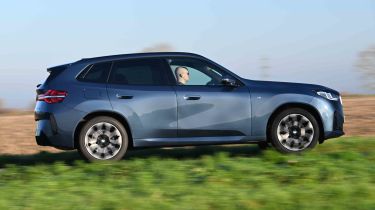BMW X3 - MPG, emissions & running costs
Hybrid tech boosts the X3’s combustion engines, while the PHEV delivers a decent electric-only range

During our time with the BMW X3 20 petrol, we achieved just over 35mpg, although we found that the official WLTP figure of 40.4mpg would be feasible on a motorway run, unlike the Lexus, which thrives in town.
Of course, the diesel model, which is identically priced and capable of returning up to 47.9mpg, should do better in the real world and will suit higher-mileage drivers.
The plug-in hybrid model will deliver much more with regular home charges, although given its list price is £8,900 more than the petrol in a matching trim level, and £7,500 more than the diesel, you’ll have to rack up thousands of EV-only miles to offset the purchase cost.
| Model | MPG | CO2 | Insurance group |
| X3 20 xDrive | 40.9mpg | 156g/km | 32 |
| X3 20d xDrive | 48.7mpg | 153g/km | 33 |
| X3 30e xDrive | 282.5mpg | 22g/km | 38 |
| X3 M50 | 36.7mpg | 175g/km | 42 |
Electric range, battery life and charge time
Major revisions were undertaken to improve the latest BMW X3 plug-in hybrid over the old model. Badged xDrive30e, the PHEV version now features a 22.3kWh battery unit – 10kWh more than you got in the previous generation. The extra battery capacity means all-electric range sits at a maximum 56 miles (compared to 29 miles from before). That’s better than the outgoing Audi Q5 TFSI e’s 37 miles, but some way off the Mercedes GLC 300 e’s 80 miles.
Charging times aren’t rapid, with a maximum recharge rate of 11kWh from the on-board cable. You can expect a 20 to 80 per cent top-up to take around 2 hours, 15 minutes.
Used - available now
In addition to BMW’s three-year, unlimited mileage warranty, the PHEV’s battery is under warranty for up to six years or 60,000 miles.
| Model | Battery size | Range | Insurance group |
| X3 30e xDrive | 19.7kWh (usable) | 56 miles | 38 |
Tax
The PHEV model makes the most sense to company car drivers. The 30e xLine sits in the eight per cent BiK (Benefit-in-kind) tax band for the 2024/2025 financial year, which means a higher-rate income taxpayer will face deductions of just over £1,800 – almost half as much as the base petrol model.
The £40,000-plus price tag of every X3 means that the whole range is subject to an extra Vehicle Excise Duty (VED) fee for the first five years, costing £590 at current rates.
Insurance groups
Depending on trim, insurance groups for the X3 range from 32 to 42. The diesel sits one group higher than the petrol, while the PHEV starts in group 38 for xLine trim.
Depreciation
Residual values are expected to be fairly strong for the X3, with the range likely to hold its value better than rivals such as the Audi Q5 and Mercedes GLC. Depending on model, the X3 should be worth between 50 and 55 per cent of its original price after three years; the engine and trim combination at the top of that list is the 20 xDrive M Sport.
To get an accurate valuation for a specific model, check out our valuation tool...














